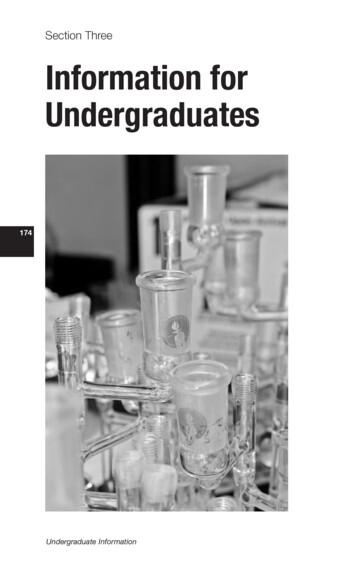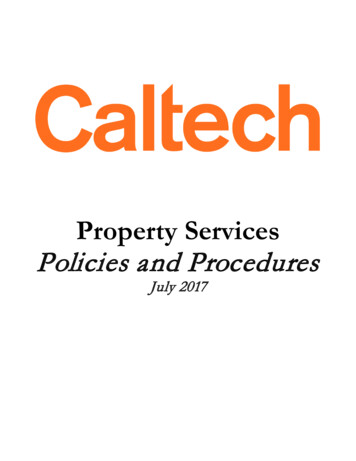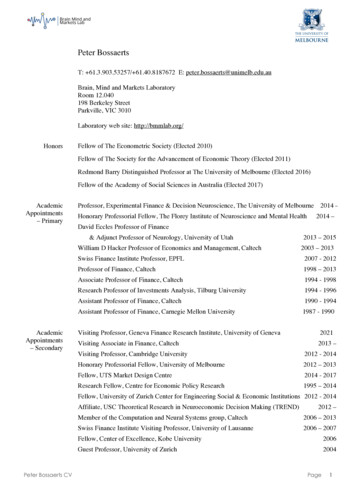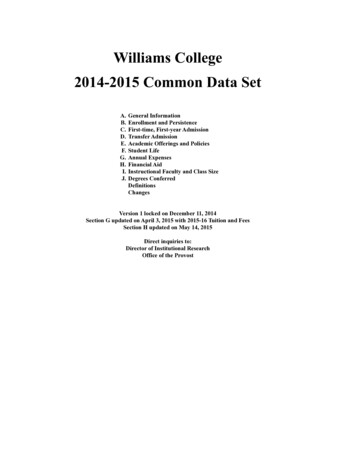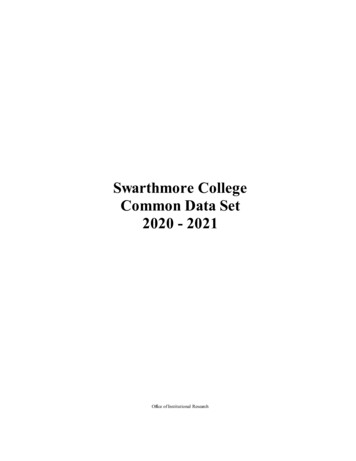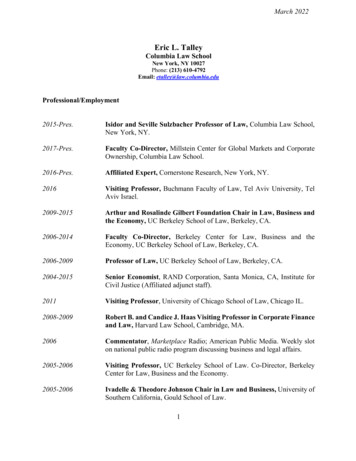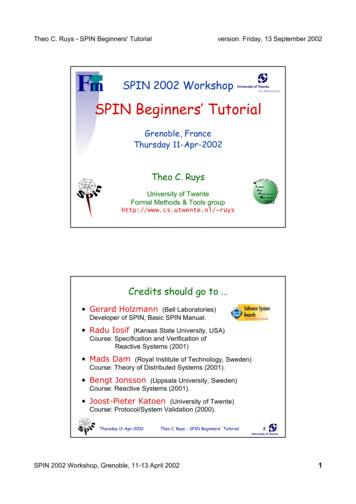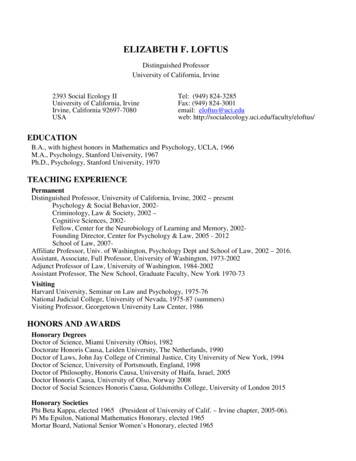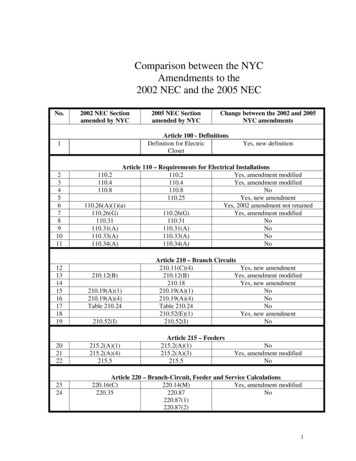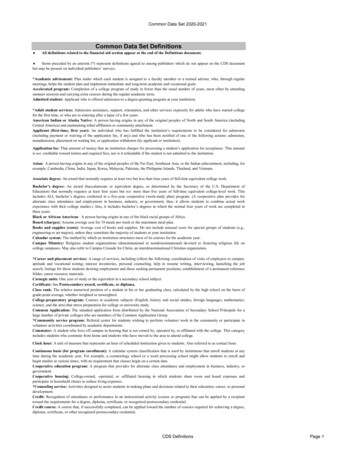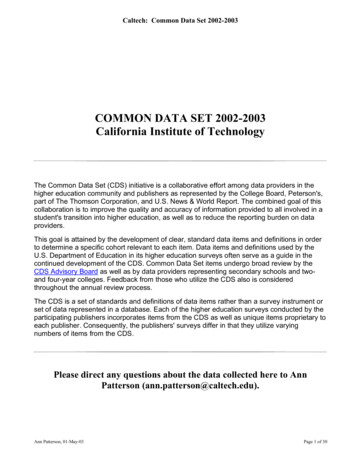
Transcription
Caltech: Common Data Set 2002-2003COMMON DATA SET 2002-2003California Institute of TechnologyThe Common Data Set (CDS) initiative is a collaborative effort among data providers in thehigher education community and publishers as represented by the College Board, Peterson's,part of The Thomson Corporation, and U.S. News & World Report. The combined goal of thiscollaboration is to improve the quality and accuracy of information provided to all involved in astudent's transition into higher education, as well as to reduce the reporting burden on dataproviders.This goal is attained by the development of clear, standard data items and definitions in orderto determine a specific cohort relevant to each item. Data items and definitions used by theU.S. Department of Education in its higher education surveys often serve as a guide in thecontinued development of the CDS. Common Data Set items undergo broad review by theCDS Advisory Board as well as by data providers representing secondary schools and twoand four-year colleges. Feedback from those who utilize the CDS also is consideredthroughout the annual review process.The CDS is a set of standards and definitions of data items rather than a survey instrument orset of data represented in a database. Each of the higher education surveys conducted by theparticipating publishers incorporates items from the CDS as well as unique items proprietary toeach publisher. Consequently, the publishers' surveys differ in that they utilize varyingnumbers of items from the CDS.Please direct any questions about the data collected here to AnnPatterson (ann.patterson@caltech.edu).Ann Patterson, 01-May-03Page 1 of 30
Caltech: Common Data Set 2002-2003Table of ContentsA. GENERAL INFORMATIONB. ENROLLMENT AND PERSISTENCEC. FIRST-TIME, FIRST-YEAR (FRESHMAN) ADMISSIOND. TRANSFER ADMISSIONE. ACADEMIC OFERINGS AND POLICIESF. STUDENT LIFEG. ANNUAL EXPENSESH. FINANCIAL AIDI.INSTRUCTIONAL FCULTY AND CLASS SIZEJ. DEGREES CONFERREDCommon Data Set Definitions 2002Ann Patterson, 01-May-03Page 2 of 30
Caltech: Common Data Set 2002-2003A. GENERAL INFORMATIONA1. Address InformationName of College or UniversityCALIFORNIA INSTITUTE OF TECHNOLOGYMailing Address, City/State/Zip/Country 1200 E. CALIFORNIA BLVD.Street Address (if different), City/State/Zip/Country PASADENA, CA 91125Main Phone Number(626) 395-6811WWW Home Page Addresswww.caltech.eduAdmissions Phone Number(626) 395-6341Admissions Toll-free NumberAdmissions Office Mailing Address, City/State/Zip/CountryAdmissions Fax Number (626) 683-3026Admissions E-mail Addressugadmissions@caltech.eduIs there a separate URL application site on the Internet? If so, please specify:http://www.admissions.caltech.edu/applying caltech.htmA2. Source of institutional control (check one only)PublicPrivate (nonprofit)ProprietaryA3. Classify your undergraduate institution:Coeducational collegeMen’s collegeWomen’s collegeA4. Academic year calendarSemesterQuarterTrimesterOther (describe):4-1-4ContinuousDiffers by program (describe):A5. Degrees offered by your inalBachelor’sAnn Patterson, 01-May-03Postbachelor’s certificateMaster’sPost-master’s certificateDoctoralFirst professionalFirst professional certificatePage 3 of 30
Caltech: Common Data Set 2002-2003B. ENROLLMENT AND PERSISTENCEB1. Institutional Enrollment—Men and Women Provide numbers of students for each of the following categories as ofthe institution’s official fall reporting date or as of October 15, tesDegree-seeking, first-timefreshmenOther first-year, degreeseekingAll other 69323486831300Total degree-seekingAll other undergraduatesenrolled in credit coursesTotal undergraduatesFirst-professionalFirst-time, first-professionalstudentsAll other first-professionalsTotal first-professionalGraduateDegree-seeking, first-timeAll other degree-seekingAll other graduates enrolledin credit coursesTotal graduateTotal all undergraduates:939Total all graduate and professional students:GRAND TOTAL ALL STUDENTS:Ann Patterson, 01-May-031,1812,120Page 4 of 30
Caltech: Common Data Set 2002-2003B2. Enrollment by Racial/Ethnic Category. Provide numbers of undergraduate students for each of the followingcategories as of the institution’s official fall reporting date or as of October 15, 2002. Include international students only inthe category "Nonresident aliens." Complete the “Total Undergraduates” column only if you cannot provide data for the firsttwo columns.Degree-seekingFirst-time First yearNonresident aliensBlack, non-HispanicAmerican Indian or Alaskan NativeAsian or Pacific IslanderHispanicWhite, non-HispanicRace/ethnicity unknownTotalDegree-seekingUndergraduates(include first-timefirst-year)672TotalUndergraduates(both degree- and 2689395268939PersistenceB3. Number of degrees awarded by your institution from July 1, 2001, to June 30, 2002.Certificate/diplomaAssociate degreesBachelor’s degreesPostbachelor’s certificatesMaster’s degreesPost-master’s certificatesDoctoral degreesFirst professional degreesFirst professional certificates249126139Graduation RatesThe items in this section correspond to data elements collected by the IPEDS Web-based Data Collection System’sGraduation Rate Survey (GRS). For complete instructions and definitions of data elements, see the IPEDS GRS instructionsand glossary on the 2002 Web-based survey.For Bachelor’s or Equivalent ProgramsReport for the cohort of full-time first-time bachelor’s (or equivalent) degree-seeking undergraduate students who entered infall 1996. Include in the cohort those who entered your institution during the summer term preceding fall 1996.B4. Initial 1996 cohort of first-time, full-time bachelor’s (or equivalent) degree-seeking undergraduate students; total allstudents:216B5. Of the initial 1996 cohort, how many did not persist and did not graduate for the following reasons: deceased,permanently disabled, armed forces, foreign aid service of the federal government, or official church missions; totalallowable exclusions:B6. Final 1996 cohort, after adjusting for allowable exclusions:(Subtract question B5 from question B4)216B7. Of the initial 1996 cohort, how many completed the program in four years or less (by August 31, 2000):Ann Patterson, 01-May-03156Page 5 of 30
Caltech: Common Data Set 2002-2003B8. Of the initial 1996 cohort, how many completed the program in more than four years but in five years or less (afterAugust 31, 2000 and by August 31, 2001):21B9. Of the initial 1996 cohort, how many completed the program in more than five years but in six years or less (afterAugust 31, 2001 and by August 31, 2002):6B10. Total graduating within six years (sum of questions B7, B8, and B9):183B11. Six-year graduation rate for 1996 cohort (question B10 divided by question B6):85%For Two-Year Institutions:B12. Initial 1999 cohort, total of first-time, full-time degree/certificate-seeking students:B13. Of the initial 1999 cohort, how many did not persist and did not graduate for the following reasons: deceased,permanently disabled, armed forces, foreign aid service of the federal government, or official church missions; totalallowable exclusions:B14. Final 1999 cohort, after adjusting for allowable exclusions(Subtract question B13 from question B12)B15. Completers of programs of less than two years duration (total):B16. Completers of programs of less than two years within 150 percent of normal time:B17. Completers of programs of at least two but less than four years (total):B18. Completers of programs of at least two but less than four-years within 150 percent of normal time:B19. Total transfers-out (within three years) to other institutions:B20. Total transfers to two-year institutions:B21. Total transfers to four-year institutions:Retention RatesReport for the cohort of all full-time, first-time bachelor’s (or equivalent) degree-seeking undergraduate students whoentered in fall 2001 (or the preceding summer term). The initial cohort may be adjusted for students who departed for thefollowing reasons: deceased, permanently disabled, armed forces, foreign aid service of the federal government or officialchurch missions. No other adjustments to the initial cohort should be made.B22. For the cohort of all full-time bachelor’s (or equivalent) degree-seeking undergraduate students who entered yourinstitution as freshmen in fall 2001 (or the preceding summer term), what percentage was enrolled at your institution asof the date your institution calculates its official enrollment in fall 2002?95%Ann Patterson, 01-May-03Page 6 of 30
Caltech: Common Data Set 2002-2003C. FIRST-TIME, FIRST-YEAR (FRESHMAN) ADMISSIONApplicationsC1. First-time, first-year (freshman) students: Provide the number of degree-seeking, first-time, first-year students whoapplied, were admitted, and enrolled (full- or part-time) in fall 2002. Include early decision, early action, and studentswho began studies during summer in this cohort. Applicants should include only those students who fulfilled therequirements for consideration for admission (i.e., who completed actionable applications) and who have been notifiedof one of the following actions: admission, non-admission, placement on waiting list, or application withdrawn (byapplicant or institution). Admitted applicants should include wait-listed students who were subsequently offeredadmission.Total first-time, first-year (freshman) men who appliedTotal first-time, first-year (freshman) women who applied2,014601Total first-time, first-year (freshman) men who were admittedTotal first-time, first-year (freshman) women who were admitted373187Total full-time, first-time, first-year (freshman) men who enrolled 179Total part-time, first-time, first-year (freshman) men who enrolledTotal full-time, first-time, first-year (freshman) women who enrolled 73Total part-time, first-time, first-year (freshman) women who enrolledC2. Freshman wait-listed students (students who met admission requirements but whose final admission wascontingent on space availability)YesNoDo you have a policy of placing students on a waiting list?If yes, please answer the questions below for fall 2002 admissions:Number of qualified applicants placed on waiting listNumber accepting a place on the waiting listNumber of wait-listed students admitted200150Admission RequirementsC3. High school completion requirementCheck the appropriate box to identify your high school completion requirement for degree-seeking entering students:High school diploma is required and GED is acceptedHigh school diploma is required and GED is not acceptedHigh school diploma or equivalent is not requiredC4. Does your institution require or recommend a general college-preparatory program for degree-seeking students?RequireRecommendNeither require nor recommendAnn Patterson, 01-May-03Page 7 of 30
Caltech: Common Data Set 2002-2003C5. Distribution of high school units required and/or recommended. Specify the distribution of academic high schoolcourse units required and/or recommended of all or most degree-seeking students using Carnegie units (one unit equalsone year of study or its equivalent). If you use a different system for calculating units, please convert.Units RequiredTotal academic unitsNot specifiedEnglishMathematicsScienceOf these, units that must be labForeign languageSocial studiesHistoryAcademic electivesOther (specify)3421Not specified11Not specifiedUnits Recommended4Basis for SelectionC6. Do you have an open admission policy, under which virtually all secondary school graduates or students with GEDequivalency diplomas are admitted without regard to academic record, test scores, or other qualifications? If so, checkwhich applies:Open admission policy as described above for all studentsOpen admission policy as described above for most students, butselective admission for out-of-state studentsselective admission to some programsother (explain)C7. Relative importance of each of the following academic and nonacademic factors in your first-time, first-year,degree-seeking (freshman) admission decisions.Very ImportantImportantConsideredNot ConsideredAcademicSecondary school recordClass rankRecommendation(s)Standardized test scoresEssayNonacademicInterviewExtracurricular activitiesTalent/abilityCharacter/personal qualitiesAlumni/ae relationGeographical residenceState residencyReligious affiliation/commitmentMinority statusVolunteer workWork experienceAnn Patterson, 01-May-03Page 8 of 30
Caltech: Common Data Set 2002-2003SAT and ACT PoliciesC8. Entrance examsA. Does your institution make use of SAT I, SAT II, or ACT scores in admission decisions for first-time, first-year, degreeYesNoseeking applicants?If yes, place check marks in the appropriate boxes below to reflect your institution’s policies for use in admission.RequireRecommendADMISSIONRequire forSomeConsider IfSubmittedNot UsedSAT IACTSAT I or ACT (no preference)SAT I or ACT--SAT I preferredSAT I or ACT--ACT preferredSAT I and SAT IISAT I and SAT II or ACTSAT IIIn addition, does your institution use applicants' test scores for placement or counseling?YesNoPlacementYesNoCounselingB. Does your institution use the SAT I or II or the ACT for placement only? If so, please mark the appropriate boxesbelow:RequirePLACEMENTRecommendRequire forsomeSAT ISAT IIACTSAT I or ACTC. Latest date by which SAT I or ACT scores must be received for fall-term admissionLatest date by which SAT II scores must be received for fall-term admissionD. If necessary, use this space to clarify your test policies (e.g., if tests are recommended for some students, or if tests arenot required of some students):Ann Patterson, 01-May-03Page 9 of 30
Caltech: Common Data Set 2002-2003Freshman ProfileProvide percentages for ALL enrolled, degree-seeking, full-time and part-time, first-time, first-year (freshman) studentsenrolled in fall 2002, including students who began studies during summer, international students/nonresident aliens, andstudents admitted under special arrangements.C9. Percent and number of first-time, first-year (freshman) students enrolled in fall 2002 who submitted nationalstandardized (SAT/ACT) test scores. Include information for ALL enrolled, degree-seeking, first-time, first-year(freshman) students who submitted test scores. Do not include partial test scores (e.g., mathematics scores but notverbal for a category of students) or combine other standardized test results (such as TOEFL) in this item. SAT scoresshould be recentered scores. The 25th percentile is the score that 25 percent scored at or below; the 75th percentilescore is the one that 25 percent scored at or above.Percent submitting SAT scores100%Number submitting SAT scores252Percent submitting ACT scoresNumber submitting ACT scoresSAT I VerbalSAT I MathACT CompositeACT EnglishACT Math25th Percentile71076075th Percentile780800Percent of first-time, first-year (freshman) students with scores in each T I Verbal81181SAT I Math982ACTCompositeACT EnglishACT Math30-3624-2918-2312-176-11Below 6C10. Percent of all degree-seeking, first-time, first-year (freshman) students who had high school class rank withineach of the following ranges (report information for those students from whom you collected high school rankinformation).Percent in top tenth of high school graduating class99%Percent in top quarter of high school graduating class100%Percent in top half of high school graduating class100%Percent in bottom half of high school graduating classPercent in bottom quarter of high school graduating classPercent of total first-time, first-year (freshman) students who submitted high school class rank:Ann Patterson, 01-May-0375%Page 10 of 30
Caltech: Common Data Set 2002-2003C11. Percentage of all enrolled, degree-seeking, first-time, first-year (freshman) students who had high school gradepoint averages within each of the following ranges (using 4.0 scale). Report information only for those studentsfrom whom you collected high school GPA.Percent who had GPA of 3.0 and higherPercent who had GPA between 2.0 and 2.99Percent who had GPA between 1.0 and 1.99Percent who had GPA below 1.0C12. Average high school GPA of all degree-seeking, first-time, first-year (freshman) students who submitted GPA:Percent of total first-time, first-year (freshman) students who submitted high school GPA: %Admission PoliciesC13. Application feeDoes your institution have an application fee?Amount of application fee: 50.00Can it be waived for applicants with financial need?YesNoYesNoYesNoC14. Application closing dateDoes your institution have an application closing date?Application closing date (fall): January 1Priority date:C15. Are first-time, first-year students accepted for terms other than the fall?YesNoC16. Notification to applicants of admission decision sent (fill in one only)On a rolling basis beginning (date):By (date):April 1Other:C17. Reply policy for admitted applicants (fill in one only)Must reply by (date):May 1No set date:Must reply by May 1 or within weeks if notified thereafterOther:C18. Deferred admission: Does your institution allow students to postpone enrollment after admission?YesNoIf yes, maximum period of postponement:C19. Early admission of high school students: Does your institution allow high school students to enroll as full-time, firstYesNotime, first-year (freshman) students one year or more before high school graduation?C20. Common Application: Will you accept the Common Application distributed by the National Association ofYesNoSecondary School Principals if submitted?YesNoIf “yes,” are supplemental forms required?YesNoIs your college a member of the Common Application Group?Ann Patterson, 01-May-03Page 11 of 30
Caltech: Common Data Set 2002-2003Early Decision and Early Action PlansC21. Early decision: Does your institution offer an early decision plan (an admission plan that permits students to apply andbe notified of an admission decision well in advance of the regular notification date and that asks students to commit toYesNoattending if accepted) for first-time, first-year (freshman) applicants for fall enrollment?If “yes,” please complete the following:First or only early decision plan closing dateFirst or only early decision plan notification dateOther early decision plan closing dateOther early decision plan notification dateFor the Fall 2002 entering class:Number of early decision applications received by your institutionNumber of applicants admitted under early decision planPlease provide significant details about your early decision plan:C22. Early action: Do you have a nonbinding early action plan whereby students are notified of an admission decision wellin advance of the regular notification date but do not have to commit to attending your college?YesNoIf “yes,” please complete the following:Early action closing dateEarly action notification dateAnn Patterson, 01-May-03November 1December 31Page 12 of 30
Caltech: Common Data Set 2002-2003D. TRANSFER ADMISSIONFall ApplicantsD1. Does your institution enroll transfer students?YesNo(If no, please skip to Section E)If yes, may transfer students earn advanced standing credit by transferring credits earned from course work completedYesNoat other colleges/universities?D2. Provide the number of students who applied, were admitted, and enrolled as degree-seeking transfer students in fall2002.MenWomenTotalApplicants16645211Admitted Applicants12315Enrolled Applicants7310Application for AdmissionD3. Indicate terms for which transfers may enroll:FallWinterSpringSummerD4. Must a transfer applicant have a minimum number of credits completed or else must apply as an entering freshman?YesNoIf yes, what is the minimum number of credits and the unit of measure?D5. Indicate all items required of transfer students to apply for admission:High school transcriptCollege transcript(s)Essay or personal statementInterviewStandardized test scoresStatement of good standingfrom prior institution(s)Requiredof AllXXXRecommendedof AllRecommendedof SomeRequired ofSomeNot requiredXXXD6. If a minimum high school grade point average is required of transfer applicants, specify(on a 4.0 scale):D7. If a minimum college grade point average is required of transfer applicants, specify(on a 4.0 scale):3.0D8. List any other application requirements specific to transfer applicants:Ann Patterson, 01-May-03Page 13 of 30
Caltech: Common Data Set 2002-2003D9. List application priority, closing, notification, and candidate reply dates for transfer students. If applications arereviewed on a continuous or rolling basis, place a check mark in the “Rolling admission” column.Priority DateFallWinterSpringSummerClosing DateNotification DateReply DateMarch 1June 1June 15D10. Does an open admission policy, if reported, apply to transfer students?YesRollingAdmissionNoD11. Describe additional requirements for transfer admission, if applicable:Transfer Credit PoliciesD12. Report the lowest grade earned for any course that may be transferred for credit:D13. Maximum number of credits or courses that may be transferred from a two-year institution:NumberUnit typeD14. Maximum number of credits or courses that may be transferred from a four-year institution:NumberUnit typeD15. Minimum number of credits that transfers must complete at your institution to earn an associate degree:D16. Minimum number of credits that transfers must complete at your institution to earn a bachelor’s degree:D17. Describe other transfer credit policies:Ann Patterson, 01-May-03Page 14 of 30
Caltech: Common Data Set 2002-2003E. ACADEMIC OFFERINGS AND POLICIESE1. Special study options: Identify those programs available at your institution. Refer to the glossary for definitions.Accelerated programCooperative (work-study) programCross-registrationDistance learningDouble majorDual enrollmentEnglish as a Second Language (ESL)Exchange student program (domestic)External degree programOther (specify):Honors programIndependent studyInternshipsLiberal arts/career combinationStudent-designed majorStudy abroadTeacher certification programWeekend collegeE2. Has been removed from the CDS.E3. Areas in which all or most students are required to complete some course work prior to graduation:Arts/fine artsComputer literacyEnglish (including composition)Foreign languagesHistoryOther (describe):HumanitiesMathematicsPhilosophySciences (biological or physical)Social scienceLibrary CollectionsReport the number of holdings. Refer to the IPEDS 2000 Academic Libraries Survey, Section D "Library Collections, FY2000", lines 26-30, column 2 for corresponding equivalents.E4. Books, serial backfiles, and other materials including government documents (paper titles--line 27) that are accessiblethrough the library’s catalog: 1,107,226E5. Current serial subscriptions in paper and microform--not electronic--including government documents (line 29): 3,210E6. Microforms (units--line 28):613,155E7. Audiovisual materials (units--line 30):3,490Ann Patterson, 01-May-03Page 15 of 30
Caltech: Common Data Set 2002-2003F. STUDENT LIFEF1. Percentages of first-time, first-year (freshman) students and all degree-seeking undergraduates enrolled in fall2002 who fit the following categories:First-time, first-yearUndergraduates(freshman) students58%Percent who are from out of state (exclude international/nonresident aliens)64%n/aPercent of men who join fraternitiesn/an/aPercent of women who join sororitiesn/a90%Percent who live in college-owned, -operated, or -affiliated housing100%10%Percent who live off campus or commute0%1%Percent of students age 25 and older0%19Average age of full-time students1819Average age of all students (full- and part-time)18F2. Activities offered Identify those programs available at your institution.Choral groupsConcert bandDanceDrama/theaterJazz bandLiterary magazineMarching bandMusic ensemblesMusical theaterOperaPep bandRadio stationStudent governmentStudent newspaperStudent-run film societySymphony orchestraTelevision stationYearbookF3. ROTC (program offered in cooperation with Reserve Officers’ Training Corps)Army ROTC is offered:On campusAt cooperating institution (name): USCNaval ROTC is offered:On campusAt cooperating institution (name):Air Force ROTC is offered:On campusAt cooperating institution (name): USC, CSU-SB, Harvey MuddF4. Housing: Check all types of college-owned, -operated, or -affiliated housing available for undergraduates at yourinstitution.Coed dormsMen’s dormsWomen’s dormsApartments for married studentsApartments for single studentsOther housing options (specify):Ann Patterson, 01-May-03Special housing for disabled studentsSpecial housing for international studentsFraternity/sorority housingCooperative housingSingle-unit housesPage 16 of 30
Caltech: Common Data Set 2002-2003G. ANNUAL EXPENSESProvide 2003-2004 academic year costs for the following categories that are applicable to your institution.Check here if your institution's 2003-2004 academic year costs are not available at this time and provide an approximatedate (i.e., month/day) when your institution's final 2003-2004 academic year costs will be available:G1. Undergraduate full-time tuition, required fees, room and boardList the typical tuition, required fees, and room and board for a full-time undergraduate student for the FULL 2003-2004academic year (30 semester hours or 45 quarter hours for institutions that derive annual tuition by multiplying credithour cost by number of credits). A full academic year refers to the period of time generally extending from September toJune; usually equated to two semesters, two trimesters, three quarters, or the period covered by a four-one-four plan.Room and board is defined as double occupancy and 19 meals per week or the maximum meal plan. Required feesinclude only charges that all full-time students must pay that are not included in tuition (e.g., registration, health, oractivity fees.) Do not include optional fees (e.g., parking, laboratory use).FIRST-YEARUNDERGRADUATESPRIVATE INSTITUTIONS: 23,901 23,901PUBLIC INSTITUTIONSIn-district:In-state (out-of-district):Out-of-state:NONRESIDENT ALIENS:REQUIRED FEES:ROOM AND BOARD:(on-campus)ROOM ONLY:(on-campus)BOARD ONLY:(on-campus meal plan) 23,901 23,901 216 216 7,560 7,560 4,299 4,299 3,261 3,261Comprehensive tuition and room and board fee (if your college cannot provide separate tuition and room and boardfees):Other:G2. Number of credits per term a student can take for the stated full-time tuitionG3. Do tuition and fees vary by year of study (e.g., sophomore, junior, senior)?36 minimumYesmaximumNoG4. If tuition and fees vary by undergraduate instructional program, describe briefly:G5. Provide the estimated expenses for a typical full-time undergraduate student:ResidentsCommutersCommuters(living at home)(not living athome)Books and supplies: 1,005 1,005 1,005Room only: 4,299Board only: 3,261 3,261Transportation:Other expenses: 3,729 1,845 3,729Ann Patterson, 01-May-03Page 17 of 30
Caltech: Common Data Set 2002-2003G6. Undergraduate per-credit-hour charges:PRIVATE INSTITUTIONS: 663PUBLIC INSTITUTIONSIn-district:In-state (out-of-district):Out-of-state:NONRESIDENT ALIENS:Ann Patterson, 01-May-03Page 18 of 30
Caltech: Common Data Set 2002-2003H. FINANCIAL AIDAid Awarded to Enrolled Undergraduates (available on request)Aid to Undergraduate Degree-seeking Nonresident Aliens (available on request)Process for First-Year/Freshman StudentsH7. Check off all financial aid forms domestic first-year (freshman) financial aid applicants must submit:FAFSAInstitution’s own financial aid formCSS/Financial Aid PROFILEState aid formNon-custodial (Divorced/Separated) Parent’s StatementBusiness/Farm SupplementOther:H8. Check off all financial aid forms nonresident alien first-year financial aid applicants must submit:Institution’s own financial aid formCSS/Financial Aid PROFILEForeign Student’s Financial Aid ApplicationForeign Student’s Certification of FinancesOther:H9. Indicate filing dates for first-year (freshman) students:Priority date for filing required financial aid forms: January 15Deadline for filing required financial aid forms:January 15No deadline for filing required forms (applications processed on a rolling basis):H10. Indicate notification dates for first-year (freshman) students (answer a or b):a.) Students notified on or about (date):April 15b.) Students notified on a rolling basis: yes/noIf yes, starting date:NoH11. Indicate reply dates:Students must reply by (date): May 1, 2003Ann Patterson, 01-May-03or within4weeks of notification.Page 19 of 30
Caltech: Common Data Set 2002-2003Types of Aid AvailablePlease check off all types of aid available to undergraduates at your institution:H12. LoansFEDERAL DIRECT STUDENT LOAN PROGRAM (DIRECT LOAN)Direct Subsidized Stafford LoansDirect Unsubsidized Stafford LoansDirect PLUS LoansFEDERAL FAMILY EDUCATION LOAN PROGRAM (FFEL)FFEL Subsidized Stafford LoansFFEL Unsubsidized Stafford LoansFFEL PLUS LoansFederal Perkins LoansFederal Nursing LoansState LoansCollege/university loans from institutional fundsOther (specify):H13. Scholarships and GrantsNEED-BASED:Federal PellSEOGState scholarships/grantsPrivate scholarshipsCollege/university gift aid from institutional fundsUnited Negro College FundFederal Nursing ScholarshipOther (specify):H14. Check off criteria used in awarding institutional aid. Check all that apply.Non-needNeed-basedAcademicsAlumni affiliationArtAthleticsJob skillsROTCAnn Patterson, 01-May-03Non-needXNeed-basedXLeadershipMinority statusMusic/dramaReligious affiliationState/district residency---------------Page 20 of 30
Caltech: Common Data Set 2002-2003I. INSTRUCTIONAL FACULTY AND CLASS SIZEI-1. Please report number of instructional
Caltech: Common Data Set 2002-2003 Ann Patterson, 01-May-03 Page 4 of 30 B. ENROLLMENT AND PERSISTENCE B1. Institutional Enrollment—Men and Women Provide numbers of students for each of the following categories as of the institution's official fall reporting date or as of October 15, 2002.
